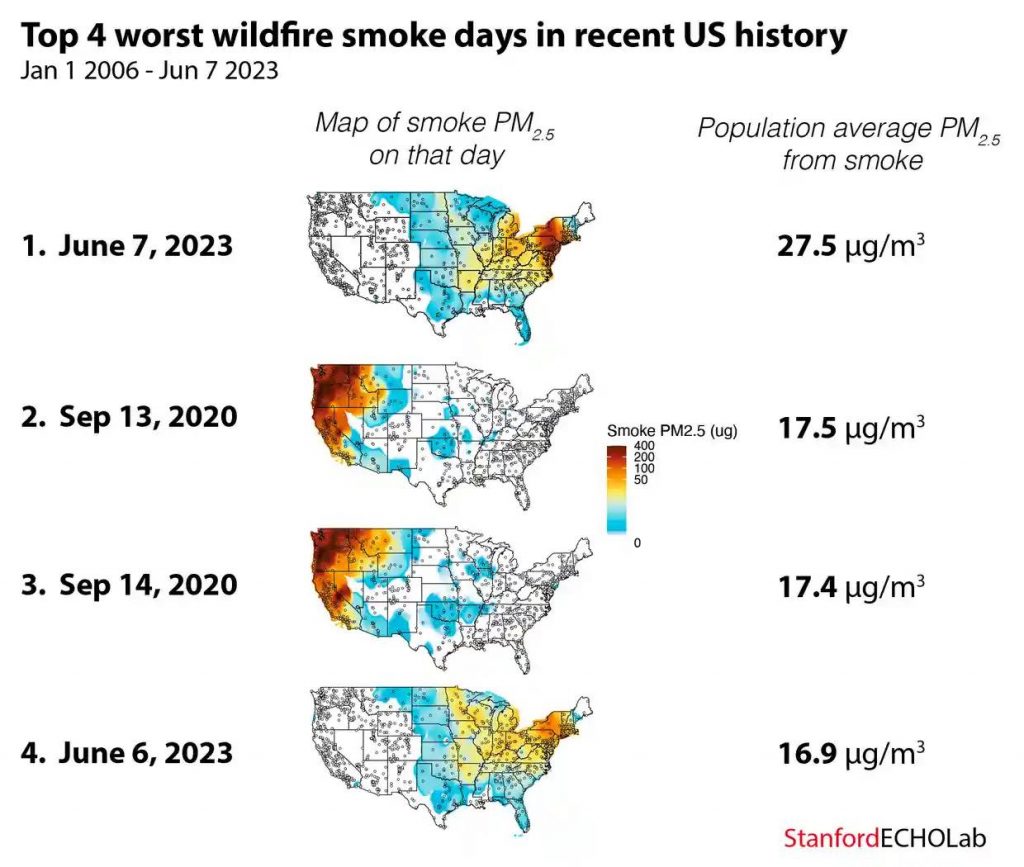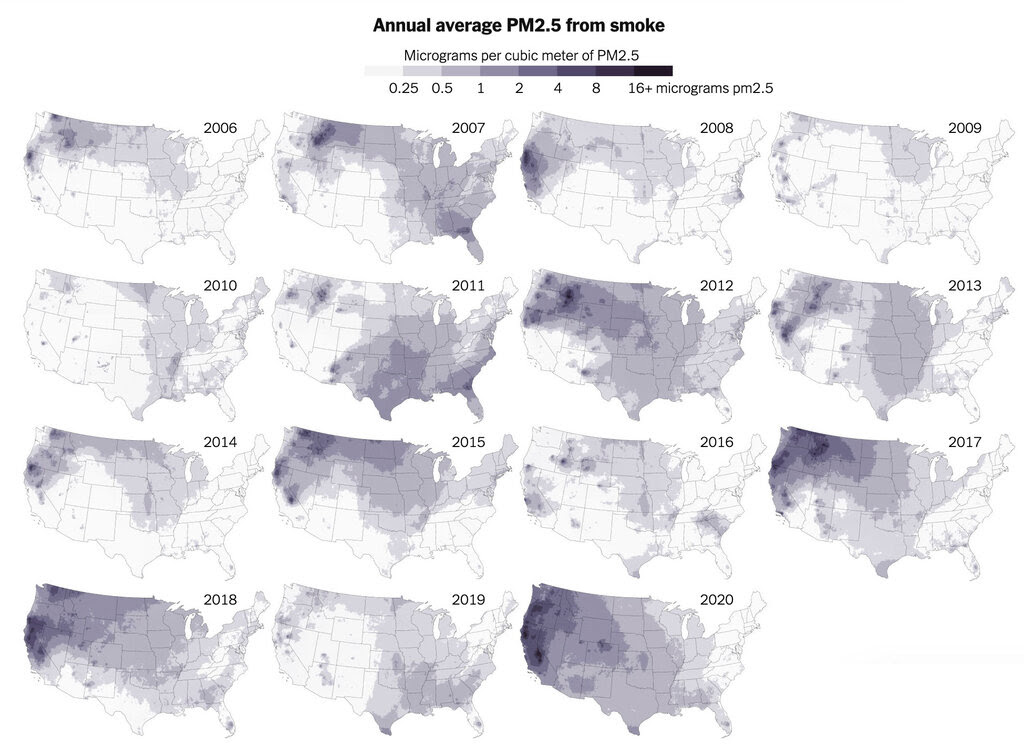https://www.valigiablu.it/canada-usa-incendi-inquinamento-atmosfera-record-crisi-climatica/
- |
“An unprecedented situation.”Thus a Quebec minister he described the hundreds of fires that fire crews have been trying to put out across Canada for weeks.A formula that we are hearing repeated a little too often lately to comment on the extreme events that are affecting the entire globe.According to Emergency Preparedness Minister Bill Blair, more than half of the 414 fires across the country are out of control, and the hottest and driest months of the year are yet to come.
In Canada we are increasingly seeing two moments in which there are peaks in fires:in late summer and spring.“When the snow melts in the early spring and the warm, dry weather arrives very early, you have this window of vulnerability,” explained Paul Kovacs, executive director of the Institute for Catastrophic Loss Reduction at Western University.“Spring fires are much more frequent than they were 20 or 30 years ago.And if in the next few weeks we can have some peace of mind with the return of green, soon after we will be on alert again."
In Quebec, where there are more than 160 fires and smoke has reached the United States, forcing authorities to issue dozens of air quality warnings, the president of the province has urged residents to follow evacuation orders.Not so in Ontario, where President Doug Ford has not yet called for a ban on bonfires despite more than 50 fires burning in the province and surrounding communities having been living under a thick blanket of smoke for days.Ford also accused New Democratic Party leader Marit Stiles of "politicizing" the fires by responding to calls to link the blazes to human-caused climate change.“It happens every year,” Ford said, adding that lightning and bonfires are all to blame.His Minister for Natural Resources is not of the same opinion and instead declared to journalists that climate change is "real and underway".
Meanwhile, the country is discussing what actions to take, considering that Canada is increasingly grappling with high temperatures and prolonged periods of drought.“In the coming years we will have to think seriously about how to equip ourselves to face this new reality,” commented Prime Minister Justin Trudeau:the government could create an ad hoc federal agency to allow officials to “predict, protect and act.”But, Kovacs explains, Canada already has a plan:it would be enough to finance it more.
The smoke - as mentioned - has reached the United States.On June 8th air pollution he reached the worst level ever recorded.Researchers at Stanford University calculated that the average American was exposed to 27.5 micrograms per cubic meter of small particles carried into the United States by Canadian fires.These small bits of soot, dust and other burnt debris, known as PM2.5, burrow deep into the lungs when inhaled and are linked to a range of health conditions and can even cause death.“It's hard to believe, to be honest, we had to do four checks to see if it was right.We have never seen events like this, or nearly so, on the East Coast.It's a historic event,” commented Marshall Burke, an environmental scientist at Stanford University who led the work.

Axios reports that 61.8 million people in some of the most populated cities in the United States were exposed to more than 50 micrograms per cubic meter of air.On June 8, the Metropolitan Washington Council of Governments and the District Department of Energy and Environment issued an air quality alert."code purple” (the second worst), which means that the air quality is dangerous for everyone, not for the most vulnerable people.
Virtually all outdoor activities “from professional sports to Pride events, from school activities to waste collection” have been cancelled, writes The Washington Post.
New Yorkers:Here's what you need to know about this week's air quality advisory and how to protect your health.🧵 https://t.co/7QkYDA67qR
— Commissioner Ashwin Vasan, MD, PhD (@NYCHealthCommr) June 7, 2023
In New York, schools and parks banned outdoor activities and people began wearing protective gear in a way they hadn't done since the pandemic.Particulate matter reached about 195 micrograms, more than five times above the national air quality standard.“Yesterday's levels were quite dangerous, especially if you are part of a vulnerable group, particularly the elderly, children, pregnant women and people with underlying health problems,” Burke added.“I expect there will be an increase in hospitalizations for respiratory diseases, premature births and, unfortunately, deaths.”
Among the most exposed are the homeless.“They are among the oldest and therefore most likely to have problems such as hypertension, diabetes, asthma and lung problems,” explains Christy Respress, executive director of Pathways to Housing DC, a nonprofit that helps the chronically homeless.Organizations that help the homeless in New York have asked the mayor to put protocols in place, as is done in cases of extreme heat in the summer or extreme cold in the winter, to ensure that homeless people have places to go.Some Washington shelters, which normally stay open from 9 a.m. to 5 p.m., have extended their hours to accommodate people without shelter who are seeking protection from poor air quality.Public libraries also remained open.

Wildfire smoke has reversed the progress the United States has made in improving air quality under the Clean Air Act, writes Somini Sengupta in the Climate Forward newsletter of New York Times on climate change.To limit the probability of these wild fires, two targeted interventions and a more general policy can be made, continues the journalist New York Times:firstly, resort to prescribed fires, i.e. bonfires used to preventively eliminate some particularly flammable parts of the vegetation with the aim of reducing the risk of fires in specific areas, and to mechanical thinning;second, do not consider pollution from prescribed fires to be of human origin (currently the Environmental Protection Agency consider smoke from wild fires as natural pollution, and smoke from prescribed fires as man-made pollution, and this should change);finally, reduce fossil fuel emissions.
Although there is no specific research yet that they attribute this week's events to global warming, the science is unequivocal:Global warming significantly increases the chances of severe wildfires and heat waves like those affecting much of North America today.The federal government's latest National Climate Assessment he related “man-made climate change” with the increase in forest fires, which have accelerated with global warming caused by fossil fuel emissions.When carbon released from fires is released into the atmosphere, global temperatures rise, further drying out land and vegetation, making them more susceptible to fires.
Scientific evidence already suggests that the effects of the Canadian fires seen in the eastern states of the United States could be repeated in the near future, he declared Chris Field, director of the Stanford Woods Institute for the Environment, al Washington Post.“There is a growing body of evidence that a warming climate is producing more extreme events, especially high temperatures and droughts.These are exactly the conditions that set the stage for really damaging wild fires,” Field added.
As in the boreal forests of North America, climate change is making Siberia's fire season longer and more severe.It also increased lightning ignitions, said Brendan Rogers, a boreal forest fire expert at the Woodwell Climate Research Center.Sure, there are different conditions in different years, he said in an email, but “the common denominator is hot/hot and dry conditions that favor ecosystem burning.”
Where does all this excess heat in the atmosphere go?Much of it is absorbed by the oceans, which is why ocean temperatures have risen steadily in recent decades, reaching record levels in 2022.And this spring saw the warmest temperatures in 40 years.This increase could report the arrival of El Niño, this weather pattern that brings heat to the surface of the eastern Pacific Ocean.The presence of El Niño in a world that is already warming due to climate change could promise "an extraordinary year of extreme phenomena globally", he wrote on Twitter Jeff Berardelli, meteorologist for WFLA, a television station in Tampa, Florida.
“We can't predict with certainty when the next big fire will be, but we will need to prepare for these events more than we have in the past,” added Jeff Schlegelmilch, director of the National Center for Disaster Preparedness at Columbia University.
Nevertheless, writes again Somini Sengupta in another article, the richest continent in the world is still unprepared to face the risks of a not too distant future.“I hope this is the right time to understand that we must act on climate change.We've gone three years of not going out because of Covid and now we can't go out because of the polluted air.The world and nature are telling us something, they are sending us a very strong message." he commented Francesca Dominici, expert on air pollution and climate at Harvard University.
“Once again, nature is sending us an unmistakable message:we better get serious about mitigating the consequences of human-induced climate change,” he echoes her Eugene Robinson, columnist of Washington Post.“And we, as a species, are a bunch of idiots if we don't make the transition from fossil fuels to clean energy sources our top global priority.”
In New York, state lawmakers are considering banning some new connections to so-called "natural gas" for electricity generation, a measure hailed by climate advocates as an economic transition away from fossil fuels in the state.
But there are those who, like the Republican senators, he continues to deny the impact of climate change on forest fires.“We've had fires our whole lives, come on,” said Sen. Tommy Tuberville (R-Ala.).“We're all for the environment, but this is just another situation where you have to work in the forests.It's a shame that this happens.This too shall pass."Evidently the message is not yet clear.
Preview image:Video frames Guardian
